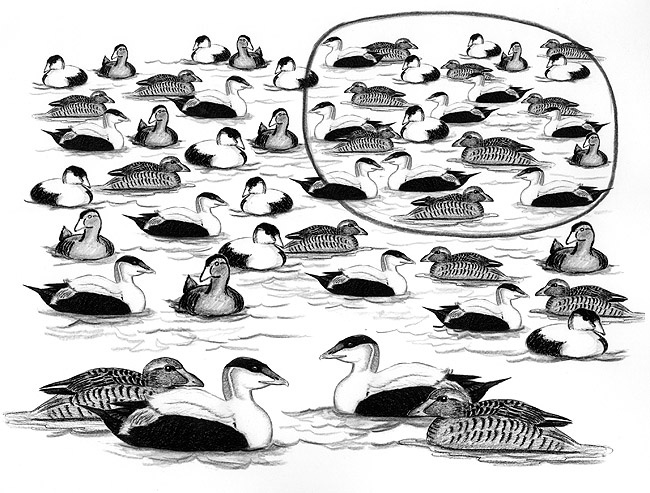
Dear Bird Folks,
I read about a large flock of ducks that were seen on a recent bird count. The number reported was in the thousands. I’d like to know how they obtained this total. How are they able to count that many birds, and more importantly, why do they do it?
– Sandi, Doylestown, PA
It’s not easy, Sandi,
Counting birds can be tricky, but there are two scientific formulas that have been created to help make counting easier. The most common method is to count the number of wings seen in a given area and then divide by two. Thus, if you count 44 wings and divide by two (44 ÷ 2), you can be pretty sure that there are 22 birds in the flock. If you count 45 wings, that means you either counted wrong or one of the birds had only one wing. (It was probably the bird flying in circles.) The second method is to count all the beaks in a flock and then multiply by one (22 x 1 = 22). I prefer this method because it takes less counting, plus I hate doing division.
When a birder reports seeing, say, 1,200 Snow Geese, many people react by thinking, “Birders have too much time on their hands.” While I have to admit that standing around all day counting birds does seem superfluous, especially in light of the world’s problems and the crisis with Two and a Half Men, but it’s actually important. Most of us see birds as energetic and entertaining (or as a way to sell expensive birdseed), but they are actually important environmental indicators. It was the decline of Bald Eagles, and other birds, that made us realize that DDT wasn’t as fabulous as we first thought it was. A struggling loon population helped highlight the problems with acid rain, and the virtual disappearance of Red Knots quickly pointed out the over-fishing of horseshoe crabs in Delaware Bay.
Birders and naturalists are constantly counting birds. In the fall there are shorebird and waterfowl counts. In the spring there are breeding bird surveys. Cornell’s Project Feeder Watch asks folks to keep track of all their feeder birds. The best known of all the counts is the annual Christmas count, where birders throughout the country head out on Christmas Day (or thereabout) and count every single bird they see. Not only is the Christmas count an important tool for keeping track of population trends, but it also gives birders an excuse to get out of the house and away from their relatives for a few hours.
There are only two requirements to participate in these counts. First, you must have the ability to identify birds; second, you have to be able to count. And believe it or not, the counting part can be far more difficult. Anyone can count the number of robins picking up worms on their front lawn, but counting robins that have gathered in a large winter flock is considerably more challenging. Counting the number of Common Eiders bobbing around in a harbor is a piece of cake. Even I can do that. But counting a raft of eiders, diving in and out of the waves, 300 feet offshore, while standing in a snow squall, is ridiculously difficult. Yet, some birders do it. (It’s counts like this that makes going back to a house filled with relatives the better option.)
The most common method of counting a large flock of, say, ducks on the water, is to divide the flock into sections. (If you happen to have any graph paper left over from middle school, it would actually come in handy right now; if not, just make a grid in your mind.) You can divide the flock into two sections, or three, or four, or more, depending upon the size of the flock. Then count all the ducks in one section and multiply that number by the number of sections. If you counted thirty ducks in a section and have divided the flock into six sections, then six times thirty equals 180 ducks. Done!
Other times birds are on the move and the graph method doesn’t quite work. In some locations we see thousands of birds streaming into an evening roost or lines of migrating birds winging their way south. In cases like these birders will actually time the birds. They’ll count how many birds fly by them for, say, a minute. Then they’ll time how long it takes for all the birds to fly past. If it takes one minute for 120 robins to fly into a roost and it takes twenty minutes for all the robins to enter the roost, then it’s estimated that 2,400 robins are using this roost on that evening. A massive flock of robins is a great spectacle if you are a birder, but not so great if you happen to be a worm.
Are these methods of counting birds 100% accurate? Heck, no. They could be off plus or minus ten or twenty percent, depending on the skill of the observer. But annual counts do help plot population trends. Also, the recent popularity of digital photography has given birders the ability to take photos of large flocks and then more accurately count the birds later on their computer screens.
Here’s one last piece of advice, Sandi. If you’re ever asked to count a huge gathering of roosting birds, it’s best to do it from a distance. You shouldn’t stand underneath any large flock unless you are wearing a big hat and perhaps a pair of goggles, too.